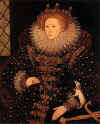
Mary, Queen of Scots Home Page
Click to view a larger version
Elizabeth I, Queen of England from 1558 to 1603, is famous for the glamour of her court, the success of her policies, and her long-preserved virginity. She was born on 7th September 1533, the daughter of Henry VIII and his second wife, Anne Boleyn. Henry, who had just had his marriage to Catherine of Aragon annulled and married Anne in the hope of begetting a male heir, was initially disappointed at Elizabeth's birth. He soon convinced himself, however, that Anne would eventually produce a son. When she failed to do so and when suspicion of infidelity was cast upon her, she was executed in 1536. Elizabeth thus grew up without a mother's care, although Henry’s last wife, Catherine Parr, was for a time an affectionate stepmother.
Her reign began on 17th November 1558 when Mary died. Elizabeth immediately named Sir William Cecil (later Lord Burghley) her chief minister, and with his help she concluded the famous Elizabethan Settlement for the Church of England. Religion in England had been unsettled since Henry VIII's break with the pope in 1533. Moderate Protestantism had been practised under Henry, and more radical Protestant programs were implemented under Edward VI; but Mary had restored the Roman Catholic faith and papal jurisdiction to England. Elizabeth herself was a moderate Protestant. Foreign affairs, always linked with religion, presented an ongoing threat to Elizabeth's security. The great fear was that an alliance of Catholic powers might force her from the throne and reintroduce a Catholic monarch. In the end no such Catholic league was formed, but Elizabeth did send English forces to fight on the Protestant side in two European conflicts, the Wars of Religion in France and the revolt of the Dutch against Spanish rule.
The position of Mary, Queen of Scots threatened Elizabeth's safety as well. Mary was the granddaughter of Henry VIII's sister Margaret Tudor by King James IV of Scotland. After the death of her first husband, Francis II of France, Mary returned to Scotland, but her subjects rebelled against her, and in 1568 she fled to England. Since she was a Roman Catholic she immediately became the focus for a number of Catholic conspiracies; these included the Northern Rebellion (1569),the Ridolfi Plot (1571), the Throckmorton Plot (1583), and the Babington Conspiracy (1586). For many years, Elizabeth worried by the idea of creating a precedent if she ordered the execution of another monarch and how this would reflect on her, resisted demands that Mary be condemned to death. She eventually signed her death warrant in 1587.
Although Elizabeth never married, she had many suitors. She was greatly attracted to Robert Dudley, earl of Leicester, and might have wed him had he not been suspected (probably incorrectly) of murdering his wife, Amy Robsart. Elizabeth rejected an offer of marriage from the Spanish king, Philip II, but she did allow lengthy courtships by two members of the French royal family--the duc d'Anjou, who became King Henry III, and his brother Francois, duc d'Alencon. Since Elizabeth had no children and there were no other descendants of Henry VIII, the Tudor line was extinguished upon her death. Throughout her reign Elizabeth refused to designate a successor, but it is clear that she expected King James VI of Scotland to follow her. When Elizabeth died on 24th March 1603, James, the son of Mary, Queen of Scots, but a Protestant, succeeded without incident as James I of England.